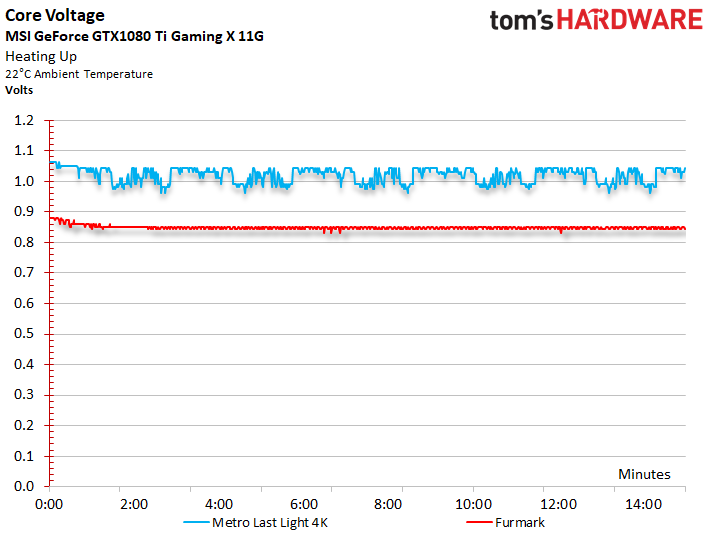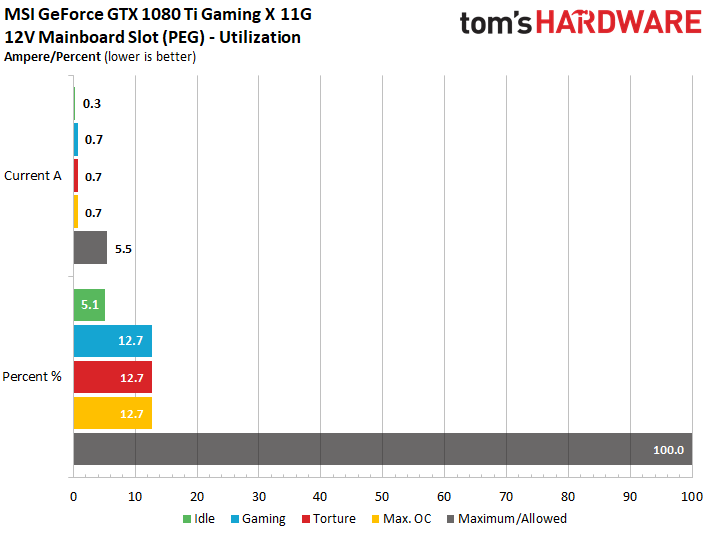MSI GeForce GTX 1080 Ti Gaming X 11G Review
Why you can trust Tom's Hardware
Power Consumption
By default, this card's power target is limited to ~290W. That ceiling is almost reached during gaming workloads, and it's hit squarely when we apply a stress test.
Increasing the power target to ~330W using MSI's Afterburner software doesn't improve performance, surprisingly enough. After all, more aggressive GPU Boost frequencies are held back by voltages and temperatures, not power.
Watching the voltage as this card heats up helps explain its behavior. The 1.0625V we measured at the beginning quickly falls to a peak of 1.05V during our gaming loop, but it can also drop even lower when there's a spike in utilization. The same phenomenon occurs during our stress test, though the values dip even further.
Gaming Power Consumption
Let's break the power consumption measurement into separate, higher-resolution lines for each supply rail over a two-minute interval. In spite of our intelligent low-pass filter, occasional spikes remain visible. In places, they reach up to 360W.
The graph corresponding to our current measurement looks just as hectic.
Stress Test Power Consumption
Faced with a more consistent load, power consumption does rise a little. However, the peaks are almost completely eliminated. Instead, we see where GPU Boost kicks in to start limiting power use.
The isolated current readings behave similarly.
Get Tom's Hardware's best news and in-depth reviews, straight to your inbox.
Exploring Limits: Maximum Overclock And The Stress Test
Increasing the power target to its ~330W maximum setting makes the readings more frenetic again. And in addition to the spikes, many dips become visible as well. These are attributable to the limiting control of GPU Boost.
Our current measurements don't reveal any abnormalities in the distribution of load on the supply rails.
Load on the Motherboard Slot
Ever since the launch of AMD's Radeon RX 480, we've been asked to include this metric in our reviews. But MSI's GeForce GTX 1080 Ti Gaming X 11G gives us no reason to be concerned about load on the motherboard's 16-lane PCIe 3.0 slot. In fact, the slot is hardly used at all. Given the power target's adjustable ceiling, we're glad to see MSI leaning hardest on the auxiliary power connectors. This also simplifies the board layout a bit.
MORE: Best Graphics Cards
MORE: Desktop GPU Performance Hierarchy Table
MORE: All Graphics Content
Current page: Power Consumption
Prev Page Gaming Performance Next Page Clock Rates, Cooling, And Noise
Igor Wallossek wrote a wide variety of hardware articles for Tom's Hardware, with a strong focus on technical analysis and in-depth reviews. His contributions have spanned a broad spectrum of PC components, including GPUs, CPUs, workstations, and PC builds. His insightful articles provide readers with detailed knowledge to make informed decisions in the ever-evolving tech landscape
-
Scorpionking20 Thanks. I would love a database of clocks/temps/noise comparing differing cards. I'm looking to sidegrade my 1070's to a 1080ti, and am not in a rush. Noise bugs me a lot more than others, so I try to go for the most quiet solution...but I may be getting a Ryzen with a proper loop too, so if I did that I may get a FE card to throw into the loop...too many options.Reply -
FormatC I've already tested four cards in Germany (four more in pipeline), all other stuff is already in translation. After publishing a few more cards on US site, we will put also a kind of landing/summary page with comparable data ;)Reply
But I can't spoiler the other reviews results before publishing it ;) -
zthomas Sound and temp is it increased with this card? .. with its own cooler how much cooler? Lots of fans pushing air.. yeah I updated my case.. has three large fans.. one thing i don't get.. I have seen nothing of temperature controls, no meters nothing to indicate temperatures inside the case.. or nothing showing use a peak times during gaming..Reply -
FormatC I can't understand your question, sorry.Reply
But you can monitor the GPU temperature by yourself with tools like GPU-Z or MSI Afterburner (also with an OSD). Then compare the results with my IR pictures and you have a good point to calculate the other temps by yourself. ;) -
FormatC The problem is:Reply
Nvidia has never sampled this card.
I have here a Quadro P6000 and this card is similar. Due the thermal limits of Nvidias stock cooler it is not significant faster. Ok, a little bit, but not a whole universe. And Nvidia will not be amused, if I use a 5000 USD workstation card in gaming benchmarks ;) -
LwNickV I have a question about Overclocking, you mention you need to "max out the voltage slider". But i saw it mentioned in another review that Voltage Slider is locked for this card. So what do you mean with that statement? Is just upping the Power Target to 330 enough to reach 2000 mhz+-?Reply -
Sam Hain Reply19669306 said:I have a question about Overclocking, you mention you need to "max out the voltage slider". But i saw it mentioned in another review that Voltage Slider is locked for this card. So what do you mean with that statement? Is just upping the Power Target to 330 enough to reach 2000 mhz+-?
Tom's was given an unlocked version of MSI AB back in March to test an FE Ti with it and was done using H20 cooling; http://www.tomshardware.com/reviews/geforce-gtx-1080-ti-water-cooling,4975-2.html They also give instructions on how to manipulate AB to access the voltage settings, until a new(er), unlocked version of AB rolls...
"We're fortunate enough to have a version of MSI’s Afterburner utility unlocked especially for us. If you want access to similar settings before a new version of Afterburner is released, you can manually add your 1080 Ti to the third-party database using the VDDC_Generic_Detection entry under the VEN_10DE&DEV_1B06&SUBSYS_120F10DE&REV_?? key. A quick search online should turn up plenty of in-depth instructions on how to do this."
However, you can just move the POWER-LIMIT slider to the max, along with bumping your clock settings. These aftermarket cards will crack past 2K MHz, no problem w/out touching voltage, this card included... It's a CHAMP!








